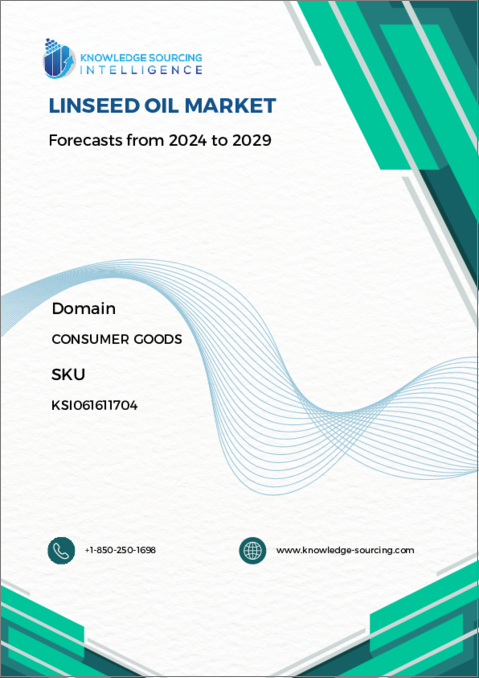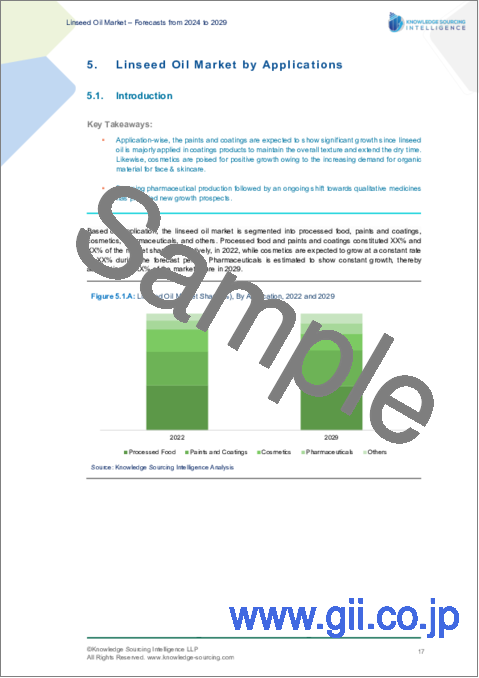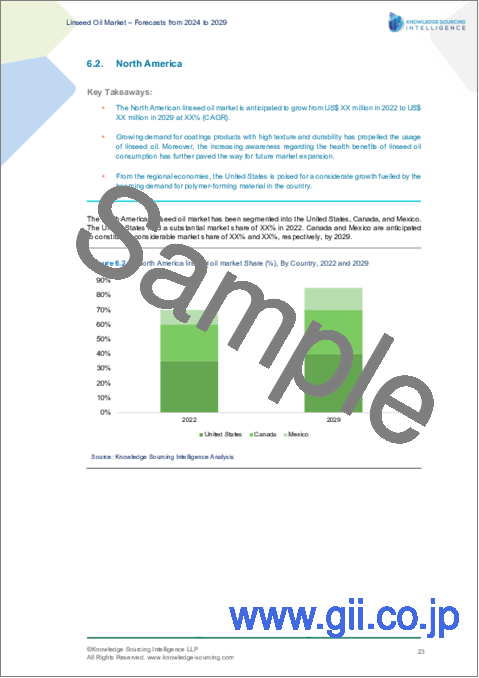|
|
市場調査レポート
商品コード
1457029
亜麻仁油市場 - 2024年~2029年までの予測Linseed Oil Market - Forecasts from 2024 to 2029 |
||||||
カスタマイズ可能
|
|||||||
| 亜麻仁油市場 - 2024年~2029年までの予測 |
|
出版日: 2024年02月08日
発行: Knowledge Sourcing Intelligence
ページ情報: 英文 124 Pages
納期: 即日から翌営業日
|
全表示
- 概要
- 目次
亜麻仁油市場は2022年に9億6,370万9,000米ドルと評価され、CAGR 5.11%で成長し、2029年には13億6,622万6,000米ドルの市場規模に達します。
亜麻仁油は、溶剤抽出プロセスを経た亜麻種子由来のエッセンシャルオイルで、医薬品、化粧品、飲食品、床材、塗料、ワニス産業で使用されます。このオイルを溶剤や樹脂とブレンドすると、固体状に重合し、優れた含浸剤として機能します。製造業ではテンパリングや触媒硬化が非常に広く使用されているため、効果的なポリマー形成材料に対する需要が増加しています。さらに、生産投資と医薬品の研究開発費の増加も市場成長の原動力になると予測されています。また、亜麻仁油の健康上の利点に対する意識の高まりも市場成長を後押ししています。このような利点から、亜麻仁油は食品、医薬品、化粧品業界で広く使用されています。また、亜麻仁はエネルギーバー、シリアル、クラッカーなどに多く使用されており、予測期間を通じてその需要は急速に伸びると予想されます。また、動物飼料の需要増加により、業界の拡大も推し進められると思われます。
アプリケーションの成長に関しては、塗装とコーティングが大きく成長すると思われます。自動車や建築物への亜麻仁油採用の増加や、塗料・コーティングへの応用機会の拡大も、主要市場プレイヤーのビジネスチャンスを広げると予想されます。
市場促進要因:
- 規制要件の増加と栄養補助食品分野のブーム
亜麻仁油は、消費者の栄養摂取量の増加に伴って人気が高まっています。胆石や心臓病の有病率が上昇し、コレステロール値や血圧値に対する懸念が高まる中、健康的な食品摂取に対するニーズが高まっています。小麦粉と特別に調製されたアマニ粉をブレンドしたリネット*(R)は、英国のLoveLinseed社から販売されています。リネット*(R)は、ケーキ、パン、ビスケット、デザート、その他様々な用途で小麦粉の代替または補完に加え、オメガ3脂肪酸の含有量を強化します。オメガ3脂肪酸は亜麻仁油に多く含まれています。一般的に、オメガ3脂肪酸は、インドの一般的な食事、特にベジタリアンの食事では不足しがちです。オメガ3は心臓、皮膚、関節の健康にとって「良い脂肪」と考えられています。ベストソース・ニュートリションの亜麻仁油カプセルには、天然ビタミンE(トコフェロール)が配合されているため、心臓、皮膚、髪の健康にさらに効果的です。こうした新発売が亜麻仁油市場を押し上げています。
- 化粧品・美容業界における使用量の増加:
消費者のオーガニック化粧品志向が高まっているため、合成品に不足しているα-リノレン酸とビタミンEを含む亜麻仁油は、その代用品として効果的に使用されるようになっています。その結果、抗炎症作用、創傷治癒作用、再生作用を併せ持つ亜麻仁油の化粧品業界への採用が急増しています。市場成長の原動力となるこれらの製品への依存の高まりは、市場の拡散を促進すると予想されます。亜麻仁油は、シャンプー、保湿剤、フェイスマスクによく使われています。アフリカン・プライドのモイスチャー・ミラクル・コレクションもその一つです。このコレクションには、シアバターと亜麻仁油モイスチャライズ&ディファインカールリングクリームが含まれています。もう一つの例として、St Botanica社はインド初の紫色のシャンプーとコンディショナーを発表しました。GOパープルシャンプー- ブロンドやブリーチした髪のために特別に処方されたこのシャンプーは、亜麻仁油、パープルマイカ、ヒマワリオイルで構成されており、カラーリングした髪を効果的に長く保つことができます。このような化粧品の発売が亜麻仁油の市場成長を後押ししています。
市場抑制要因:
- 合成塗料やアルキド樹脂が入手しやすくなっています。
オイルは一般的に遅乾性の液体であり、水に対する保存性と保護性が強化されています。亜麻仁油は木材の防腐剤として使用できるが、乾燥時間が長いため、家具やデッキのように扱ったり歩いたりするものに使用するには限界があります。速乾性で表面保護効果の高い合成塗料が入手可能であり、コストも安いため、一部の地域ではアルキド樹脂が亜麻仁に取って代わり、市場の成長を制限しています。
北米は主要な地域市場になると予想されます。
北米における亜麻仁油市場の成長と需要を後押ししているのは、いくつかの重要な要素です。この動向を後押しする重要な要因のひとつは、オメガ3脂肪酸を豊富に含むことから栄養補助食品として注目されている亜麻仁油の健康上の利点に関する消費者の知識が高まっていることです。さらに、亜麻仁油の需要は、塗料、コーティング剤、木材仕上げ剤などの産業分野、特に家具産業や建築産業の拡大に伴う多くの用途によって牽引されています。また、環境に優しい製品を求める一般的な動向に沿った、バイオベースや持続可能な製品に対する需要の高まりも市場に影響を与えています。健康と福祉を求める動向や、産業用途の可能性に関する継続的な調査も、この地域における亜麻仁油の使用拡大に寄与しています。
主な発展:
- 2023年3月、ADMはKnwble GrwnTMブランドの立ち上げを発表し、持続可能な方法で生産された健康的な植物性食品成分を消費者に提供することを目指しました。小規模農家や十分な実績を持たない農家が再生農法を用いてKnwble Grwnの商品を製造し、環境保護に貢献します。この新ブランドは、ADMの既存のグリーン・プロジェクトと相性が良いです。キヌア、ヘンプシード、亜麻油、麻の実が、すべてキューに含まれています。
目次
第1章 イントロダクション
- 市場概要
- 市場の定義
- 調査範囲
- 市場セグメンテーション
- 通貨
- 前提条件
- 基準年と予測年のタイムライン
- 利害関係者にとっての主なメリット
第2章 調査手法
- 調査デザイン
- 調査プロセス
第3章 エグゼクティブサマリー
- 主な調査結果
- CXOの視点
第4章 市場力学
- 市場促進要因
- 市場抑制要因
- ポーターのファイブフォース分析
- 業界バリューチェーン分析
- アナリストビュー
第5章 亜麻仁油市場:用途別
- イントロダクション
- 加工食品
- 市場動向と機会
- 成長の見通し
- 地理的な収益性
- 塗料とコーティング
- 市場動向と機会
- 成長の見通し
- 地理的な収益性
- 化粧品
- 市場動向と機会
- 成長の見通し
- 地理的な収益性
- 医薬品
- 市場動向と機会
- 成長の見通し
- 地理的な収益性
- その他
- 市場動向と機会
- 成長の見通し
- 地理的な収益性
第6章 亜麻仁油市場:地域別
- イントロダクション
- 北米
- 用途別
- 国別
- 南米
- 用途別
- 国別
- 欧州
- 用途別
- 国別
- 中東・アフリカ
- 用途別
- 国別
- アジア太平洋
- 用途別
- 国別
第7章 競合環境と分析
- 主要企業と戦略分析
- 市場シェア分析
- 合併、買収、合意およびコラボレーション
- 競争力のあるダッシュボード
第8章 企業プロファイル
- Gustav Heess GmbH
- Cargill, Incorporated
- Archer Daniels Midland Company
- AOS PRODUCTS
- Livos Canada
The linseed oil market is evaluated at US$963.709 million for the year 2022 growing at a CAGR of 5.11% reaching the market size of US$1,366.226 million by the year 2029.
Linseed oil is an essential oil derived from flaxseeds that undergoes a solvent extraction process and is used in pharmaceuticals, cosmetics, food, and beverage, flooring, paint, and varnish industries. When this oil is blended with solvents or resins, it can polymerize into solid forms and act as an excellent impregnator. There is an increasing demand for effective polymer-forming materials due to the highly widespread use of tempering and catalyzed curing in manufacturing. Moreover, production investments and higher pharmaceutical research and development expenditures are also projected to drive market growth. Growing awareness about the health benefits of linseed oil has also been fueling market growth. As a result of these benefits, linseed oil is widely being used across the food, pharmaceutical, and cosmetic industries. In addition, with flaxseed's prominent insertion into energy bars, cereals, and crackers, its demand is expected to grow rapidly throughout the forecast period. An expansion of the industry will also be pushed due to the increasing demand for animal feed.
As far as application growth is concerned, painting and coatings will grow substantially. Increasing adoption of linseed oil into vehicles and buildings, as well as broader opportunities for application in paints & coatings, is also expected to broaden the opportunities for the key market players.
MARKET DRIVERS:
- Increasing regulatory requirements and the boom in the nutraceutical sector
Linseed oil has gained increased popularity as consumers' nutritional intake has risen. With the rising prevalence of gallstones and heart disease and mounting concerns over cholesterol and blood pressure levels, there is a growing need for healthy food intake. Linette*(R), a blend of wheat flour and specially prepared linseed flour is marketed and sold by LoveLinseed in the UK. In addition to replacing or supplementing wheat flour in cakes, bread, biscuits, desserts, and a variety of other uses, Linette*(R) provides an enhanced Omega-3 content. Omega 3 fatty acids are found in large quantities in flaxseed oil. Generally, Omega 3 fats are often missing from regular Indian diets, especially those that are vegetarian. Omega 3 is considered a "good fat" for heart, skin, and joint health. Natural Vitamin E (tocopherol) is included in BestSource Nutrition's Flaxseed oil capsules, so they are even more effective in assisting with heart, skin, and hair health. Such new launches have boosted the linseed oil market.
- Increased usage in the cosmetic and beauty industry:
Since consumers are increasingly turning towards organic cosmetic products, linseed oil is becoming an effective substitute as it contains alpha-linolenic acid and vitamin E, two substances that are lacking in synthetic products. As a result of this, the adoption of linseed oil by the cosmetic industry has proliferated due to its combination of anti-inflammatory, wound healing, and regenerative properties. The increasing reliance on these products to drive market growth is expected to fuel the proliferation of the market. Linseed oil is commonly used in shampoos, moisturizers, and facemasks. The Moisture Miracle Collection from African Pride is one such example. Among the products in this collection were Shea Butter & Linseed Oil Moisturize & Define Curling Cream. In another example, St Botanica has introduced a purple shampoo and conditioner that is India's first in the field. GO Purple Shampoo - Purposefully formulated for blonde and bleached hair, it is composed of Linseed Oil, Purple Mica, and Sunflower Oil, which effectively preserves color-treated hair for many years to come. Such cosmetic product launches have boosted the market growth for linseed oil.
MARKET RESTRAINTS:
- Synthetic paints and alkyd resins are becoming more readily available
The oil is generally a slow-drying liquid with enhanced properties of preservation and protection against water. Linseed oil can be used as a wood preservative however the longer drying time is a limitation when used on items handled or walked on, such as furniture or decks. Owing to the availability of synthetic paints for fast drying and enhanced protection of surfaces, as well as their low costs, alkyd resins have replaced linseed in some areas, thereby restricting market growth.
North America is anticipated to be the major regional market.
Several important elements together fuel the market's growth and demand for linseed oil in North America. One important factor driving this trend is growing consumer knowledge of the health advantages of linseed oil, which is positioned as a sought-after nutritional supplement due to its abundance of omega-3 fatty acids. Furthermore, the demand for linseed oil is being driven by its many uses in industrial sectors, including paints, coatings, and wood finishes, especially with the expansion of the furniture and building industries. The growing demand for bio-based and sustainable products, which is in line with the general trend towards eco-friendly options, also has an impact on the market. The trend towards health and wellbeing as well as continuing research into possible industrial uses contribute to the growing use of linseed oil in the region.
Key Developments:
- In March 2023, ADM announced the Knwble GrwnTM brand launch, aimed at offering consumers sustainably produced, healthful plant-based food components. Small or underrepresented farmers use regenerative farming approaches to make Knwble Grwn goods, which contribute to environmental protection. The new brand is a good fit with ADM's existing green projects. Quinoa, hemp seed, flax oil, and hemp seed are all included in the queue.
Segmentation:
By Application
- Processed Food
- Paints and Coatings
- Cosmetics
- Pharmaceuticals
- Others
By Geography
- North America
- USA
- Canada
- Mexico
- South America
- Brazil
- Argentina
- Others
- Europe
- United Kingdom
- Germany
- France
- Spain
- Others
- Middle East and Africa
- Saudi Arabia
- UAE
- Israel
- Others
- Asia Pacific
- China
- India
- South Korea
- Taiwan
- Thailand
- Indonesia
- Japan
- Others
TABLE OF CONTENTS
1. INTRODUCTION
- 1.1. Market Overview
- 1.2. Market Definition
- 1.3. Scope of the Study
- 1.4. Market Segmentation
- 1.5. Currency
- 1.6. Assumptions
- 1.7. Base, and Forecast Years Timeline
- 1.8. Key Benefits to the stakeholder
2. RESEARCH METHODOLOGY
- 2.1. Research Design
- 2.2. Research Processes
3. EXECUTIVE SUMMARY
- 3.1. Key Findings
- 3.2. CXO Perspective
4. MARKET DYNAMICS
- 4.1. Market Drivers
- 4.2. Market Restraints
- 4.3. Porter's Five Forces Analysis
- 4.3.1. Bargaining Power of Suppliers
- 4.3.2. Bargaining Power of Buyers
- 4.3.3. Threat of New Entrants
- 4.3.4. Threat of Substitutes
- 4.3.5. Competitive Rivalry in the Industry
- 4.4. Industry Value Chain Analysis
- 4.5. Analyst View
5. LINSEED OIL MARKET, BY APPLICATION
- 5.1. Introduction
- 5.2. Processed Food
- 5.2.1. Market Trends and Opportunities
- 5.2.2. Growth Prospects
- 5.2.3. Geographic Lucrativeness
- 5.3. Paints and Coatings
- 5.3.1. Market Trends and Opportunities
- 5.3.2. Growth Prospects
- 5.3.3. Geographic Lucrativeness
- 5.4. Cosmetics
- 5.4.1. Market Trends and Opportunities
- 5.4.2. Growth Prospects
- 5.4.3. Geographic Lucrativeness
- 5.5. Pharmaceuticals
- 5.5.1. Market Trends and Opportunities
- 5.5.2. Growth Prospects
- 5.5.3. Geographic Lucrativeness
- 5.6. Others
- 5.6.1. Market Trends and Opportunities
- 5.6.2. Growth Prospects
- 5.6.3. Geographic Lucrativeness
6. LINSEED OIL MARKET, BY GEOGRAPHY
- 6.1. Introduction
- 6.2. North America
- 6.2.1. By Application
- 6.2.2. By Country
- 6.2.2.1. USA
- 6.2.2.1.1. Market Trends and Opportunities
- 6.2.2.1.2. Growth Prospects
- 6.2.2.2. Canada
- 6.2.2.2.1. Market Trends and Opportunities
- 6.2.2.2.2. Growth Prospects
- 6.2.2.3. Mexico
- 6.2.2.3.1. Market Trends and Opportunities
- 6.2.2.3.2. Growth Prospects
- 6.2.2.1. USA
- 6.3. South America
- 6.3.1. By Application
- 6.3.2. By Country
- 6.3.2.1. Brazil
- 6.3.2.1.1. Market Trends and Opportunities
- 6.3.2.1.2. Growth Prospects
- 6.3.2.2. Argentina
- 6.3.2.2.1. Market Trends and Opportunities
- 6.3.2.2.2. Growth Prospects
- 6.3.2.3. Others
- 6.3.2.3.1. Market Trends and Opportunities
- 6.3.2.3.2. Growth Prospects
- 6.3.2.1. Brazil
- 6.4. Europe
- 6.4.1. By Application
- 6.4.2. By Country
- 6.4.2.1. United Kingdom
- 6.4.2.1.1. Market Trends and Opportunities
- 6.4.2.1.2. Growth Prospects
- 6.4.2.2. Germany
- 6.4.2.2.1. Market Trends and Opportunities
- 6.4.2.2.2. Growth Prospects
- 6.4.2.3. France
- 6.4.2.3.1. Market Trends and Opportunities
- 6.4.2.3.2. Growth Prospects
- 6.4.2.4. Spain
- 6.4.2.4.1. Market Trends and Opportunities
- 6.4.2.4.2. Growth Prospects
- 6.4.2.5. Others
- 6.4.2.5.1. Market Trends and Opportunities
- 6.4.2.5.2. Growth Prospects
- 6.4.2.1. United Kingdom
- 6.5. Middle East and Africa
- 6.5.1. By Application
- 6.5.2. By Country
- 6.5.2.1. Saudi Arabia
- 6.5.2.1.1. Market Trends and Opportunities
- 6.5.2.1.2. Growth Prospects
- 6.5.2.2. UAE
- 6.5.2.2.1. Market Trends and Opportunities
- 6.5.2.2.2. Growth Prospects
- 6.5.2.3. Israel
- 6.5.2.3.1. Market Trends and Opportunities
- 6.5.2.3.2. Growth Prospects
- 6.5.2.4. Others
- 6.5.2.4.1. Market Trends and Opportunities
- 6.5.2.4.2. Growth Prospects
- 6.5.2.1. Saudi Arabia
- 6.6. Asia Pacific
- 6.6.1. By Application
- 6.6.2. By Country
- 6.6.2.1. China
- 6.6.2.1.1. Market Trends and Opportunities
- 6.6.2.1.2. Growth Prospects
- 6.6.2.2. India
- 6.6.2.2.1. Market Trends and Opportunities
- 6.6.2.2.2. Growth Prospects
- 6.6.2.3. South Korea
- 6.6.2.3.1. Market Trends and Opportunities
- 6.6.2.3.2. Growth Prospects
- 6.6.2.4. Taiwan
- 6.6.2.4.1. Market Trends and Opportunities
- 6.6.2.4.2. Growth Prospects
- 6.6.2.5. Thailand
- 6.6.2.5.1. Market Trends and Opportunities
- 6.6.2.5.2. Growth Prospects
- 6.6.2.6. Indonesia
- 6.6.2.6.1. Market Trends and Opportunities
- 6.6.2.6.2. Growth Prospects
- 6.6.2.7. Japan
- 6.6.2.7.1. Market Trends and Opportunities
- 6.6.2.7.2. Growth Prospects
- 6.6.2.8. Others
- 6.6.2.8.1. Market Trends and Opportunities
- 6.6.2.8.2. Growth Prospects
- 6.6.2.1. China
7. COMPETITIVE ENVIRONMENT AND ANALYSIS
- 7.1. Major Players and Strategy Analysis
- 7.2. Market Share Analysis
- 7.3. Mergers, Acquisitions, Agreements, and Collaborations
- 7.4. Competitive Dashboard
8. COMPANY PROFILES
- 8.1. Gustav Heess GmbH
- 8.2. Cargill, Incorporated
- 8.3. Archer Daniels Midland Company
- 8.4. AOS PRODUCTS
- 8.5. Livos Canada






